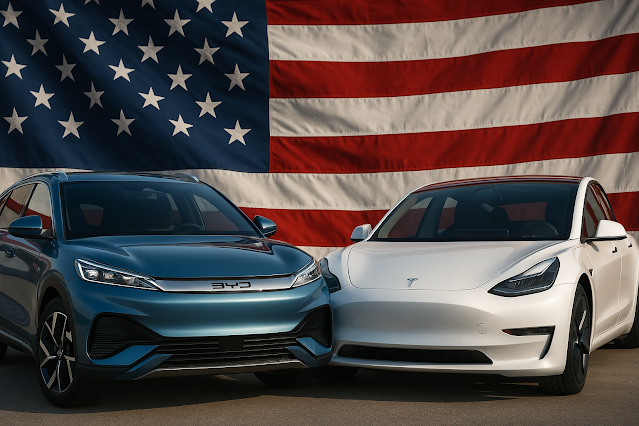The electric vehicle (EV) market in the U.S. has been dominated by Tesla for years, but a new player is making waves: China’s BYD. As of April 2025, BYD—already a global EV giant—has set its sights on the U.S., raising questions about whether Tesla should be concerned. With BYD’s aggressive pricing, innovative technology, and rapid global expansion, this blog post explores the potential impact on Tesla and the broader U.S. EV market. Let’s dive into the dynamics, challenges, and what this means for consumers and investors.
Who Is BYD, and Why Does It Matter?
BYD, short for "Build Your Dreams," is a Shenzhen-based automaker that has become the world’s leading EV manufacturer, surpassing Tesla in global sales in 2024. According to recent reports, BYD recorded annual revenue of $107 billion in 2024, edging out Tesla’s $97.7 billion. The company sold 4.27 million vehicles last year, including 1.76 million pure EVs and 2.51 million hybrids, compared to Tesla’s 1.79 million pure EVs.
BYD’s success stems from its vertically integrated supply chain, government-backed support in China, and a focus on affordability—its entry-level models start at just over $10,000 in China, while Tesla’s cheapest Model 3 retails for around $32,000.
BYD has already made significant inroads globally, dominating markets like Thailand, Brazil, and India, where it undercuts Tesla on price. In China, BYD holds a 32% share of the new energy vehicle market, dwarfing Tesla’s 6.1%. Now, with plans to enter the U.S., BYD poses a potential threat to Tesla’s stronghold.
BYD’s Entry into the U.S. Market: What’s Happening in 2025?
As of April 4, 2025, BYD has not yet started selling passenger EVs in the U.S., but the company is laying the groundwork. While high tariffs—currently at 100% on Chinese EVs—have kept BYD’s passenger cars out, the company has already introduced electric buses in California, signaling its intent to expand.
Recent reports indicate BYD is exploring strategies to circumvent tariffs, such as establishing local assembly plants in North America. The company has already announced factories in Hungary, Turkey, and Brazil. Analysts speculate a U.S. or Mexican plant could be next to reduce import costs.
The U.S. market is a tough nut to crack due to geopolitical tensions and trade barriers. President Donald Trump, who began his second term in January 2025, has pledged to raise tariffs on car imports even further. However, BYD’s focus on affordability and innovation could still make it a formidable player if it navigates these challenges successfully.
Why Should Tesla Be Worried?
-
Price Competitiveness
In markets like Southeast Asia and Latin America, BYD’s cheapest models—such as the Seagull and Dolphin—are significantly more affordable than Tesla’s Model 3. For example, in China, BYD’s Qin L sedan starts at 119,800 yuan (around $16,500), while Tesla’s Model 3 costs about 235,500 yuan (around $32,500). If BYD brings similar pricing to the U.S., it could attract budget-conscious buyers—an audience Tesla has yet to reach despite promises of a cheaper model in mid-2025. -
Technological Innovation
In 2024, BYD introduced its “Super e-Platform,” claiming a 5-minute charge can deliver 400 km (249 miles) of range, outpacing Tesla’s Supercharger system, which takes around 15 minutes for a comparable charge. BYD’s “God’s Eye” driver-assistance tech, included free on most models, rivals Tesla’s Full Self-Driving (FSD), which remains a premium add-on. -
Global Momentum and Scale
In 2024, BYD exported 417,204 vehicles—up nearly 72% from the previous year—and aims to double that to 800,000 in 2025. Meanwhile, Tesla’s deliveries declined by 1.1%, its first annual drop. BYD’s growth trajectory is aggressive and well-coordinated. -
Supply Chain Advantage
BYD’s vertical integration allows it to produce batteries, semiconductors, and chips in-house. Its Blade Battery tech is considered one of the safest on the market and is even being sourced by rivals like Ford and Toyota. Tesla’s reliance on Chinese manufacturing—especially its Shanghai Gigafactory—makes it vulnerable to geopolitical shifts.
Why Tesla Might Not Be Too Worried—Yet
-
Brand Loyalty and Market Positioning
Tesla commands a strong brand presence and loyal customer base in the U.S. Despite a 13% dip in Q1 2025 sales, Tesla’s Model Y remains one of the best-selling EVs in the country. BYD lacks that kind of recognition and will face an uphill battle winning over American consumers. -
Tariff and Policy Barriers
The U.S. government’s 100% tariff on Chinese EVs, paired with Trump’s protectionist stance, makes it costly for BYD to enter. Even with local production, issues like data privacy and labor scrutiny—as seen in Brazil—may slow their progress. -
Tesla’s Innovation Pipeline
Tesla is set to launch affordable EV models in 2025 that directly challenge BYD on price. Its continued development of FSD and dominance in charging infrastructure give it an edge that BYD will take time to replicate.
What Does This Mean for the U.S. EV Market?
BYD’s entrance—if successful—could reshape the landscape:
-
Increased Competition: Lower prices and more tech-packed options benefit consumers but may pressure smaller U.S. EV makers like Rivian and Lucid.
-
Policy Shifts: While some politicians suggest welcoming BYD factories like those of TSMC, resistance is strong amid fears of Chinese industry domination.
-
Consumer Impact: If tariffs drop or BYD manufactures locally, Americans could see feature-rich EVs at a fraction of Tesla’s price.
Should Tesla Be Worried?
Yes, but not panicked—yet. BYD’s pricing, innovation, and global scale make it a formidable challenger. But Tesla still holds the home-field advantage with brand loyalty, infrastructure, and favorable policy support.
The true test will come if BYD manages to build a U.S. plant and price its models competitively. Until then, Tesla leads—but must stay nimble.
Key Takeaways for 2025
For Consumers: Keep an eye on BYD’s U.S. entry—it could mean more affordable EVs, but tariffs may delay availability. Tesla’s upcoming budget models are also worth watching.
For Investors: BYD’s stock is up 46% in 2025, reflecting its global push. But Tesla’s $800 billion market cap still dwarfs BYD’s $157 billion. The rivalry is heating up.
-EditorZ


Post a Comment